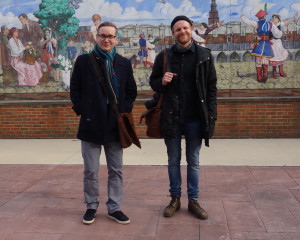Our news travels to Finland headline

Finnish journalists Heikki Karki (left) and Mikko Vahaniitty were recently in town interviewing local officials and residents about Hamtramck’s multicultural mix. Hamtramck continues to attract international journalists who find the city unique.
By Walter Wasacz
Normally, I go out looking for stories. Walkable discovery is what this column is all about, a way to document what I call my adventures close to home.
Sometimes the story comes to me.
Like it did last week when I received a call from The Review’s editor Charles Sercombe, who said two journalists from Finland were here reporting on the impact newer immigrant and refugee communities are having on Hamtramck and Dearborn.
We met the next day at Oloman Cafe for an hour-long interview, one of dozens the two men – Heikki Karki and Mikko Vahaniitty – say they conducted over several days in the area.
Heikki asked the questions, Mikko listened and took pictures. I asked about their newspaper and the perspective it takes on social and political issues. They said the paper is based in a university town north of the capital of Helsinki and that its editorial position is neither left nor right.
“Neutral” is the word they used.
I knew the refugee crisis – mostly people leaving the Middle East and Afghanistan – had been a big concern for European countries since 2014-15, when advances by the Islamic State escalated the civil war in Syria.
Germany, by far, took on most of the refugees: well over one million during the past three years. By contrast, the less populous Finland welcomed 32,000 people in 2015.
Citing the cold northern climate and some hostility shown by native Finns, thousands of Iraqi refugees voluntarily returned to their home country in 2016. That same year migration to Finland was down to less than 6,000 people.
Heikki said some in Finland – a largely homogenous, white, Lutheran nation of 5.5 million people – believed overwhelmingly Muslim migrant populations from the Middle East and West Asia would have a negative impact on Nordic culture and Finnish society.
He said stories of Hamtramck and Dearborn have reached readers all over Europe, in particular the news that Hamtramck had elected a majority Muslim city council, generating curiosity about how new community members and longtime residents get along here.
I told him that regardless of the ethnic or religious makeup of local government the city has always been politically feisty — not appreciably different now than when it was a majority Polish Catholic city.
In fact, if anything it is more tame today than it was then: for decades Hamtramck had a reputation for having one of the rowdiest council bodies of any in Michigan.
Before the charter was revised and the city had a “strong mayor” form of government, leadership battles were constant and combative.
Some tension between the “old” and “new” Hamtramck began to surface in the late 1990s, when the voters elected Gary Zych as the city’s mayor.
Zych, an artist and educator whose family had Polish roots but came from Eastpointe — was branded an “outsider.” He replaced popular nine-term incumbent and Hamtramck native Robert Kozaren.
The new mayor had some support from the city’s growing Bangladeshi community. Shahab Ahmed, the first Bangladeshi-American and Muslim member of the Hamtramck city council, entered politics as part of the Zych slate.
During the November 1999 General Election, election challengers registered under state law were found by the U.S. Attorney’s Office to have suppressed the rights of Bengali- and Arabic-speaking voters.
The challengers were part of a grass roots group calling itself “Concerned citizens of Hamtramck.” The group was made up of mostly white natives of the city.
According to a consent decree issued by the U.S. Attorney, the challengers singled out “more than 40 voters” with “dark skin” and names like “Mohamed, Ahmed and Ali.”
The intent of the concerned citizens group was to keep the election “pure,” according to the decree.
Another conflict came in 2004, when there was a conflict among some longtime residents and Muslim newcomers over the call to prayer being broadcast five times a day.
When I mentioned that, both Heikki and Mikko said they had heard about it back in Finland and from others they had interviewed while in Hamtramck, including members of the Bangladeshi and Yemeni American communities.
In summary, I told the reporters that immigration over the past 20 years has had a positive effect on Hamtramck (and Dearborn, for that matter), opening eyes and hearts to real life in a changing world.
The city has its challenges but it is a more tolerant and welcoming place today – with better food and more interesting cultural amenities – than when it was more homogenous.
We went outside to take more pictures. I held the camera this time. We picked a background painted by Hamtramck muralist Dennis Orlowski in Pope John Paul II park; then tried a shot in front of the hookah shop on the opposite corner. Both represented the city as it is now, which was the point.
Walter Wasacz was born, lives and writes in Hamtramck.

